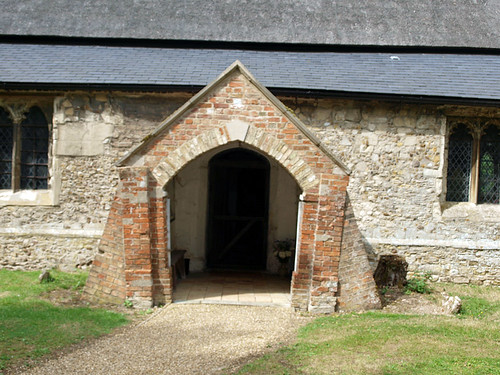ALL SAINTS. Low W tower. Thatched nave and lower tiled chancel. Evidence of many building phases, beginning with the Norman jambs of the chancel arch with three shafts separated by chamfered steps. The capitals are many-scalloped. The arch (rebuilt in the C14) is remarkably wide for a Norman village church. A blocked Norman window in the N wall. The S arcade follows, of late C13 date, four bays with short octagonal piers and double-hollow-chamfered arches. The tower also must be as early as this. It is unbuttressed and has lancets. On the top battlements. But the tower arch is Perp. The next stage is the rebuilding of the chancel, c. 1330, probably paid for by the man whose monument was originally in the ogee-headed recess in the N wall. The renewed chancel E window is of five lights with reticulated tracery, the other windows have flowing motifs with ogees. The westernmost window on the S side goes lower down than the others. Windows of the same time in the N wall of the nave and the S aisle. The W bay of the S arcade seems to have been renewed in the C15. Finally the C18 added the brick S porch which is now in such a picturesque tumble-down state. - PULPIT. Elizabethan, with tester, not big. - COMMUNION RAIL. Early C18. - PAINTING. N wall of nave ashlar pattern with roses, St Christopher and vine scrolls, a frieze of stars etc.; C15. - MONUMENTS. Fragments of Late Anglo-Saxon tomb-lids with interlace. - In the C14 chancel recess, defaced effigy of a Knight, drawing his sword, mail hood, the legs not yet crossed, later C13.
RAMPTON. A fragment of its ancient village cross still stands on the green, and its charming church behind the orchards is old enough to have had its walls not built but rebuilt 600 years ago. Part of the tower is 15th century, and so is the doorway, which brings us to a narrow aisle, separated from the wide nave by a low arcade 700 years old. The chancel arch is 12th century, and looking down on it all is a fine black and white roof with queenposts, thought to have been brought from Barnwell Priory when the monasteries were dissolved.
The chancel has a tiny low window, a double piscina, and an aumbry with its ancient door. The east window, for a long time unworthily debased, has been restored to beauty in memory of those who fell in the war, and also in memory of two rectors, one of them Charles Evelyn-White, a historian of the county. Back again in the window is much of its fine tracery of 600 years ago, which came to light with a collection of carved stones now in the east wall. Another window of the same period is that at the east of the aisle, with some 14th century glass including a small headless figure in blue and red and gold.
The canopied pulpit is a fine little example of Jacobean art, and the font is a Norman bowl standing on a small complete font of the 15th century. There are several old bench-ends, fragments of the medieval screen in the new one, traces of an old wall-painting said to be St Christopher, and much painting of a later time. A dark stone in the floor has a cross and a Lombardic inscription to Sir Nicholas de Huntingdon, of 700 years ago, and a sculpture of a knight drawing his sword is perhaps a monument to Sir Robert de Lisle, who held Rampton in Henry the Third’s day. His family built a fortified house on Giant’s Hill near the church, and its moat can still be seen.
The chancel has a tiny low window, a double piscina, and an aumbry with its ancient door. The east window, for a long time unworthily debased, has been restored to beauty in memory of those who fell in the war, and also in memory of two rectors, one of them Charles Evelyn-White, a historian of the county. Back again in the window is much of its fine tracery of 600 years ago, which came to light with a collection of carved stones now in the east wall. Another window of the same period is that at the east of the aisle, with some 14th century glass including a small headless figure in blue and red and gold.
The canopied pulpit is a fine little example of Jacobean art, and the font is a Norman bowl standing on a small complete font of the 15th century. There are several old bench-ends, fragments of the medieval screen in the new one, traces of an old wall-painting said to be St Christopher, and much painting of a later time. A dark stone in the floor has a cross and a Lombardic inscription to Sir Nicholas de Huntingdon, of 700 years ago, and a sculpture of a knight drawing his sword is perhaps a monument to Sir Robert de Lisle, who held Rampton in Henry the Third’s day. His family built a fortified house on Giant’s Hill near the church, and its moat can still be seen.



No comments:
Post a Comment